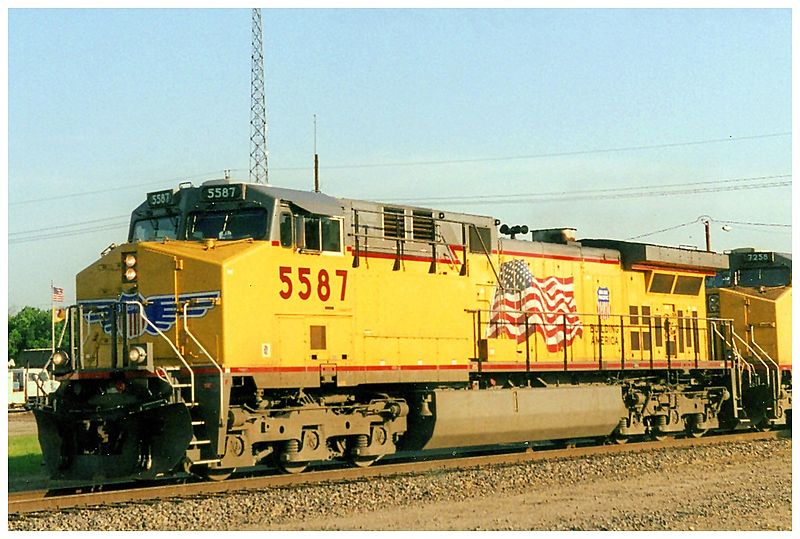In a recent column in Trains, Fred Frailey examines the long-term impact of the late Hunter Harrison’s railway management reforms:

Union Pacific locomotive 5587, a General Electric AC4400CW-CTE(AC44CWCTE)
Photo by Terry Cantrell via Wikimedia Commons.
In the year since Hunter Harrison’s death, Precision Scheduled Railroading, or PSR, has progressed from crackpot railroading (in the eyes of some railroaders and shippers) to the gold standard. And it happened so fast we are still trying to wrap our arms around what it means for the future of this industry.
The facts are these: Canadian National, Canadian Pacific, and CSX Transportation have been put through Harrison’s PSR wringer, emerging in every case much leaner in terms of productive assets — cars, locomotives, trackage, and employees. That meant tons of savings to hand to investors. Interesting to me is what happened after that. CN, which Harrison ran as president or CEO from 1998 through 2009, went on a growth spurt in that period that continues to this day. Revenue ton miles at CN — the most basic measure of what a railroad does — rose 48 percent between Harrison’s retirement in 2009 and 2017. So it’s clear that downsizing the railroad’s assets didn’t inhibit Canadian National’s growth, because no other railroad even approaches what it accomplished during this period. Revenue ton miles rose slightly during Harrison’s tenure at Canadian Pacific and are now rising faster. His successor there, Keith Creel, says CP is game to grow. That’s the same story coming from Jim Foote, who succeeded Harrison late in 2017 at CSX.
Harrison’s impact on the other railroads of North America is palpable. The man was scarcely buried before financial analysts forgot the chaos he unleashed in his hurry to implement PSR at CSX and began asking other railroads why they weren’t more like CN, CP and CSX. Union Pacific, the oldest surviving nameplate in American railroading, capitulated and began implementing PSR practices last October on the eastern part of the railroad, with a goal of expanding the transformation to the entire system within several years. Chief Executive Lance Fritz insists this isn’t a case of PSR Lite.
[…] To change the railroad, you must change the culture. Harrison did it in every instance by force majeure — if you didn’t embrace his plan, goodbye. Who will change the culture at Union Pacific? I am at a loss to know. My sources say the impetus for PSR came not from within the railroad, but from the board of directors, which puts Lance Fritz in a thankless position. He must lead the effort, but this isn’t his idea, and morale in management ranks is low to begin with. His chief operations officer is new to the job, and nothing in the man’s background shouts to me that he is up to this.
Yet there are a lot of smart people at Union Pacific, and no company of its stature launches something of this magnitude with a will to fail. I am heartened that UP began by pruning its management ranks — in 2017 it counted 3,678 executives, officials and staff assistants, versus BNSF’s 1,511. (In fairness, BNSF outsources its information technology, whereas UP does not, accounting for some of the difference.) UP revealed in late 2018 it would eliminate 500 nonunion jobs by year’s end, plus 200 contract workers.
But let’s face it: As done by Harrison, you begin the PSR process by stripping a railroad to its underwear. At CSX it meant cutting every conceivable cost, denuding the railroad of field supervisors and just about everything else, until it began to be dysfunctional. That’s when he knew he had cut enough and could add back assets to make the railroad workable. This method is like becoming pregnant; there is no half way. Union Pacific began Precision Scheduled Railroading with a go-slow approach, not wanting to punish shippers and arouse regulators. Hmm. The way to looks to me now, UP may achieve some good financial results but not the sort that Hunter Harrison could or that its directors might expect. It would be a lot easier for UP to simply buy Canadian Pacific and let Keith Creel, a Harrison acolyte who knows PSR inside and out, come in as an outsider and do the dirty work. And if the process will be hard for Union Pacific, imagine the barriers to PSR in front of BNSF, KCS, and NS, all under pressure to walk the walk but so far unwilling to do so.



